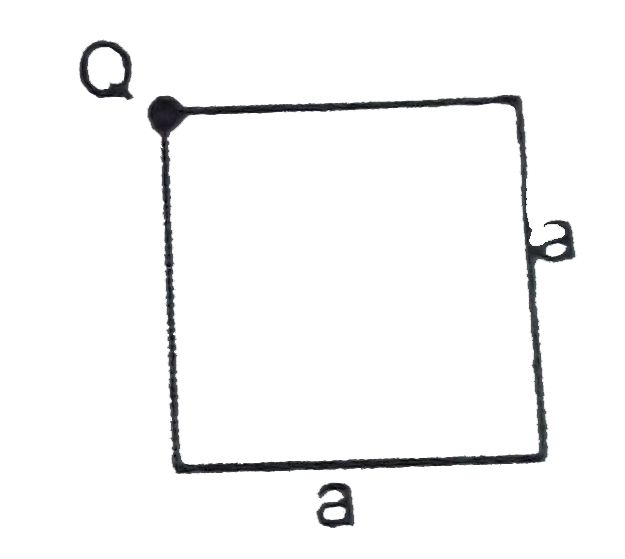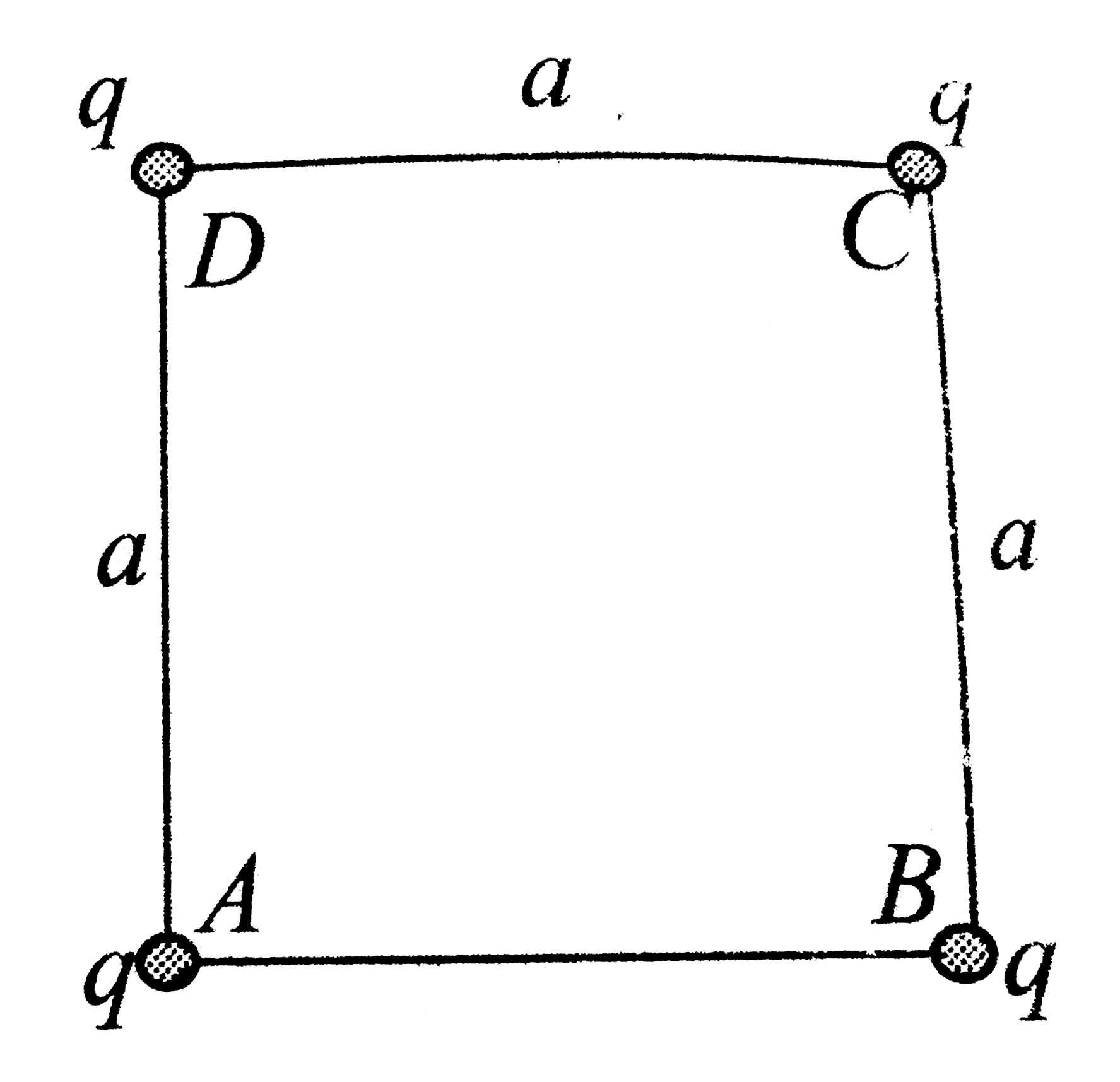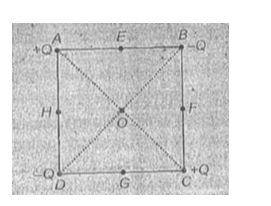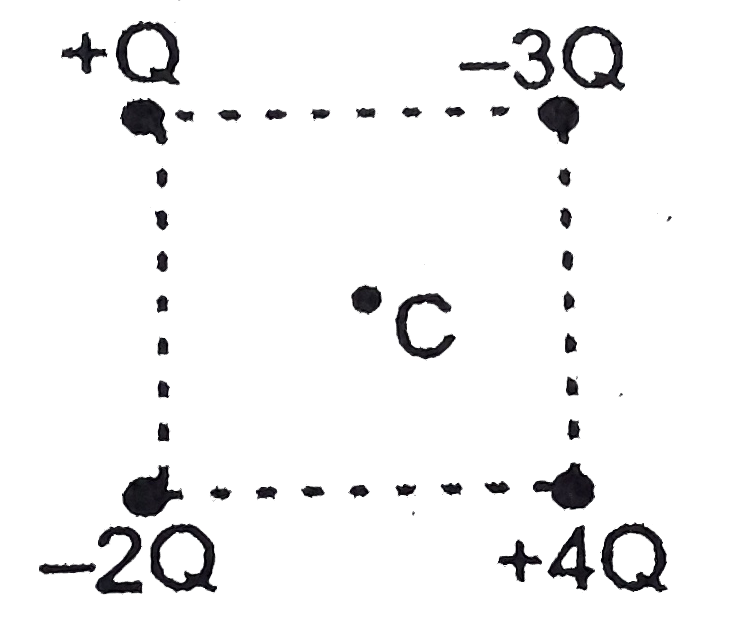Identical point charges of +1.7μC are fixed to diagonally opposite corners of a square. A third charge is then fixed at the center of the square, such that it causes the potentials at the empty corners to change signs without changing magnitudes. Find the sign and magnitude of the third charge.
−4.8μC
−3.4μC
+5.9μC
+1.7μC
The correct Answer is:A
To solve the problem, we need to determine the sign and magnitude of the third charge placed at the center of a square, given that two identical point charges of +1.7μC are fixed at diagonally opposite corners. The potential at the empty corners must change signs without changing magnitudes.
1. Understanding the Configuration:
- We have a square with sides of length a.
- Charges +1.7μC are placed at corners B and D.
- We need to find a charge q′ placed at the center of the square that changes the potential at the empty corners A and C.
2. Calculate the Potential at Corner A Without the Center Charge:
- The potential VA at corner A due to charges at corners B and D is given by:
VA=k(q1rAB+q2rAD)
- Here, q1=q2=1.7μC and the distances rAB=a and rAD=a.
- Thus,
VA=k(1.7×10−6a+1.7×10−6a)=2k1.7×10−6a=3.4ka
3. Calculate the Potential at Corner A With the Center Charge:
- When the charge q′ is placed at the center, the potential at corner A becomes:
V′A=k(1.7×10−6a+1.7×10−6a+q′d)
- The distance d from the center to any corner is a√2.
- Therefore,
V′A=k⎛⎜⎝1.7×10−6a+1.7×10−6a+q′a√2⎞⎟⎠=k(3.4×10−6a+√2q′a)
4. Setting the Condition for Changing Signs:
- According to the problem, the potential at corner A after placing the charge should equal the negative of the potential before placing the charge:
V′A=−VA
- Thus,
k(3.4×10−6a+√2q′a)=−3.4ka
5. Solving for q′:
- Canceling k/a from both sides (assuming k and a are non-zero):
3.4×10−6+√2q′=−3.4×10−6
- Rearranging gives:
√2q′=−3.4×10−6−3.4×10−6=−6.8×10−6
- Therefore,
q′=−6.8×10−6√2≈−4.8×10−6C
6. Conclusion:
- The charge q′ is approximately −4.8μC.
- Thus, the sign of the third charge is negative, and its magnitude is 4.8μC.
Final Answer:
- Sign: Negative
- Magnitude: 4.8μC
- We have a square with sides of length a.
- Charges +1.7μC are placed at corners B and D.
- We need to find a charge q′ placed at the center of the square that changes the potential at the empty corners A and C.
- The potential VA at corner A due to charges at corners B and D is given by:
VA=k(q1rAB+q2rAD)
- Here, q1=q2=1.7μC and the distances rAB=a and rAD=a.
- Thus,
VA=k(1.7×10−6a+1.7×10−6a)=2k1.7×10−6a=3.4ka
- When the charge q′ is placed at the center, the potential at corner A becomes:
V′A=k(1.7×10−6a+1.7×10−6a+q′d)
- The distance d from the center to any corner is a√2.
- Therefore,
V′A=k⎛⎜⎝1.7×10−6a+1.7×10−6a+q′a√2⎞⎟⎠=k(3.4×10−6a+√2q′a)
- According to the problem, the potential at corner A after placing the charge should equal the negative of the potential before placing the charge:
V′A=−VA
- Thus,
k(3.4×10−6a+√2q′a)=−3.4ka
- Canceling k/a from both sides (assuming k and a are non-zero):
3.4×10−6+√2q′=−3.4×10−6
- Rearranging gives:
√2q′=−3.4×10−6−3.4×10−6=−6.8×10−6
- Therefore,
q′=−6.8×10−6√2≈−4.8×10−6C
- The charge q′ is approximately −4.8μC.
- Thus, the sign of the third charge is negative, and its magnitude is 4.8μC.
- Sign: Negative
- Magnitude: 4.8μC
Topper's Solved these Questions
- ELECTRIC POTENTIALBOOK - RESNICK AND HALLIDAYCHAPTER - ELECTRIC POTENTIALEXERCISE - (PRACTICE QUESTIONS) More than One Correct Choice Type
8 Videos
- ELECTRIC POTENTIALBOOK - RESNICK AND HALLIDAYCHAPTER - ELECTRIC POTENTIALEXERCISE - (PRACTICE QUESTIONS) Linked Comprehension
2 Videos
- ELECTRIC POTENTIALBOOK - RESNICK AND HALLIDAYCHAPTER - ELECTRIC POTENTIALEXERCISE - (PROBLEMS)
47 Videos
- ELECTRIC CHARGES AND FIELDSBOOK - RESNICK AND HALLIDAYCHAPTER - ELECTRIC CHARGES AND FIELDSEXERCISE - Practice Questions (Integer Type )
3 Videos
- ELECTROMAGNETIC INDUCTIONBOOK - RESNICK AND HALLIDAYCHAPTER - ELECTROMAGNETIC INDUCTIONEXERCISE - PRACTICE QUESTIONS (Integer Type)
14 Videos
Similar Questions
Knowledge Check
Four point charge are placed at the corners of a square with diagonal 2a as shown. What is the total electric field at the center of the squre?
 Akq/a2 at an angle 45∘ above the +x-axisBkq/a2 at an angle 45∘ above the -x-axisC3kq/a2 at an angle 45∘ above the -x-axisD3kq/a2 at an angle 45∘ above the +x-axis
Akq/a2 at an angle 45∘ above the +x-axisBkq/a2 at an angle 45∘ above the -x-axisC3kq/a2 at an angle 45∘ above the -x-axisD3kq/a2 at an angle 45∘ above the +x-axisElectric charges of +10μC,+5μC,−3μC and +9μC are placed at the corners of a square of side √2m the potential at the centre of the square is
A1.8VB1.8×106VC1.8×105VD1.8×104VFour positive charges (2√2−1)Q are arranged at the four corners of a square. Another charge q is placed at the center of the square. Resulting force acting on each corner charge is zero if q is
A−7Q4B−4Q7C−QD−(√2+1)Q
Four identical point charges are placed at the corners of a square, A fifth point charge placed at the center of the square experiences zero net force . Is this a stable equilirium for the fifth charge? Explain.
View SolutionA point charge Q is placed at the corner of a square of side a, then find the flux through the square.

View SolutionEight identical point charges of q coulomb each are placed at the corners of a cube side 0.1m. Calculate electric field at the centre of the cube. Calculate the field at the center when one of the corner charges is removed.
View SolutionFour identical charges q are placed at the corners of a square of side a. Find the potential energy of one of the charges due to the remaining charges.
 .
.
View SolutionFour charges Q-Q, Q-Q are placed at the corners of a square as shown . The potential is zero at points

View Solution

